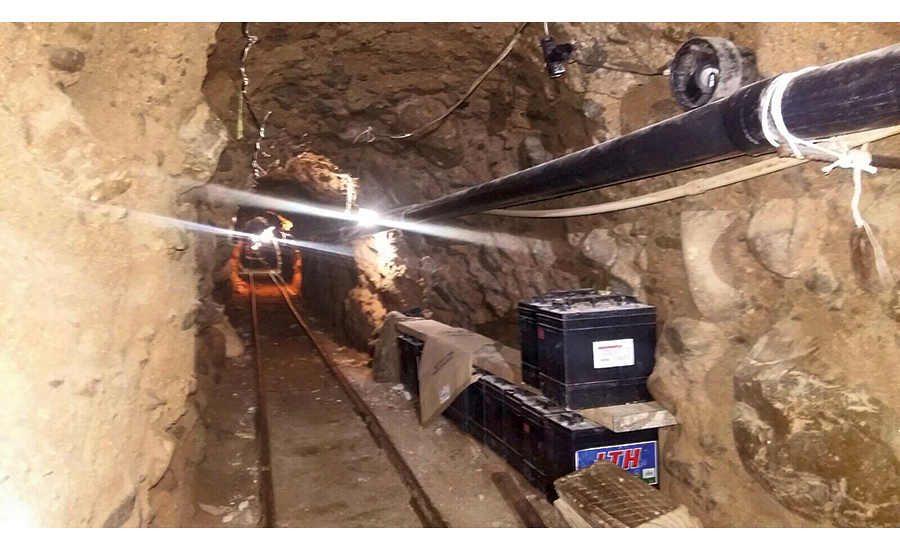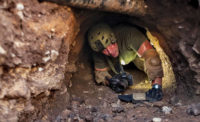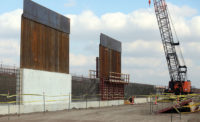In 1990, law enforcement agents discovered the first illicit cross-border tunnel, in Douglas, Ariz. Since then, the U.S. Border Patrol and Drug Enforcement Administration have uncovered at least 106 more subterranean pathways crossing the border between Mexico and the states of Arizona and California. The U.S. Border Patrol says these tunnels are rudimentary, designed to achieve the goals of the drug cartels and human traffickers who use them to smuggle drugs and people.
As cross-border traffic becomes more lucrative, so does the engineering and construction of the tunnels. The U.S. Border Patrol plugs discovered tunnels quickly, but new routes appear seemingly overnight.
Lance Lenoir, supervisory U.S. Border Patrol agent for the San Diego Border Station, says the illicit cross-border tunnels are classified according to three levels: rudimentary, interconnecting and sophisticated. Rudimentary tunnels are “gopher holes” for getting under a fence to go short distances. Interconnecting tunnels tap in or out of municipal infrastructure, such as sewer systems and storm drains. Sophisticated tunnels are built with ventilation and electrical systems, with some type of transport mechanism used for moving narcotics.
Lenoir says the tunnel used by Joaquin “El Chapo” Guzman, head of the Sinaloa Cartel, to break out of Altiplano Federal Penitentiary last July in Juarez, Mexico, was a sophisticated passageway that used a motorcycle adapted to run on rails from mines.
Agents perform a four-part remediation process after they have finished their investigation and cleared the tunnel.
“A tunnel entry team goes in and effectively maps the tunnel to get an approximation of where we are looking and where we will have to drill,” Lenoir says.
Agents then use sonde transmitters to pinpoint the tunnel’s path on the surface.
“An agent usually carries the transmitter in the tunnel, and then you have a locator up top that zeros in on that transmitter, which gives us an X on the ground. [That X] tells us, within a fair degree of accuracy, that we can drill there,” he says.
Eventually, Border Patrol crews seal the tunnels with concrete, although some of the most rudimentary are filled in with only soil.
“We get an auger bit and drill until we intercept, and then the concrete trucks come in,” Lenoir says. “It is usually a slurry mix, but for the immediate border area, which is usually within 90 to 120 feet, I usually fill that up with 3,000-psi concrete. Wet slurry cement is pretty easy to pick through … but with the 3,000 psi, they aren’t going to pick through that.”
Agents also place a bulkhead—typically a steel plate—at the border and have the system inspected. This method of sealing is very expensive, and Congress has earmarked money specifically to be used for this purpose.
For the most part, the Mexican government performs little to no remediation, Lenoir says.
George Trevino, Tucson-sector Border Patrol agent, says the tunnels are more expensive than traditional smuggling methods but are constructed quickly. Some tunnels are used multiple times, but others might be used only once. “If they used it for two weeks and, in those two weeks, they were able to pass over $10 million worth of narcotics, that would probably outweigh the cost of building the tunnel, so it is worth it for them,” he says.
Municipal infrastructure also plays a key role. Nogales sits atop miles of pipes, conduit and drainage systems—perfect pre-made structures for smugglers.
Kevin Hecht, deputy patrol agent in charge of the Nogales Border Patrol Station and a government expert on illicit cross-border tunnels, says they can start in any existing infrastructure. “Tunnels can start in existing drainage in Mexico and tap between drainage systems and into the U.S. tunnels,” he says.
Luck plays a major role in discovering the tunnels, he says, and sealing them is a matter of public safety and health.
“Every single one of these illicit cross-border tunnels is a death trap,” Hecht says. “Every one of them—make no mistake about it.”





Post a comment to this article
Report Abusive Comment